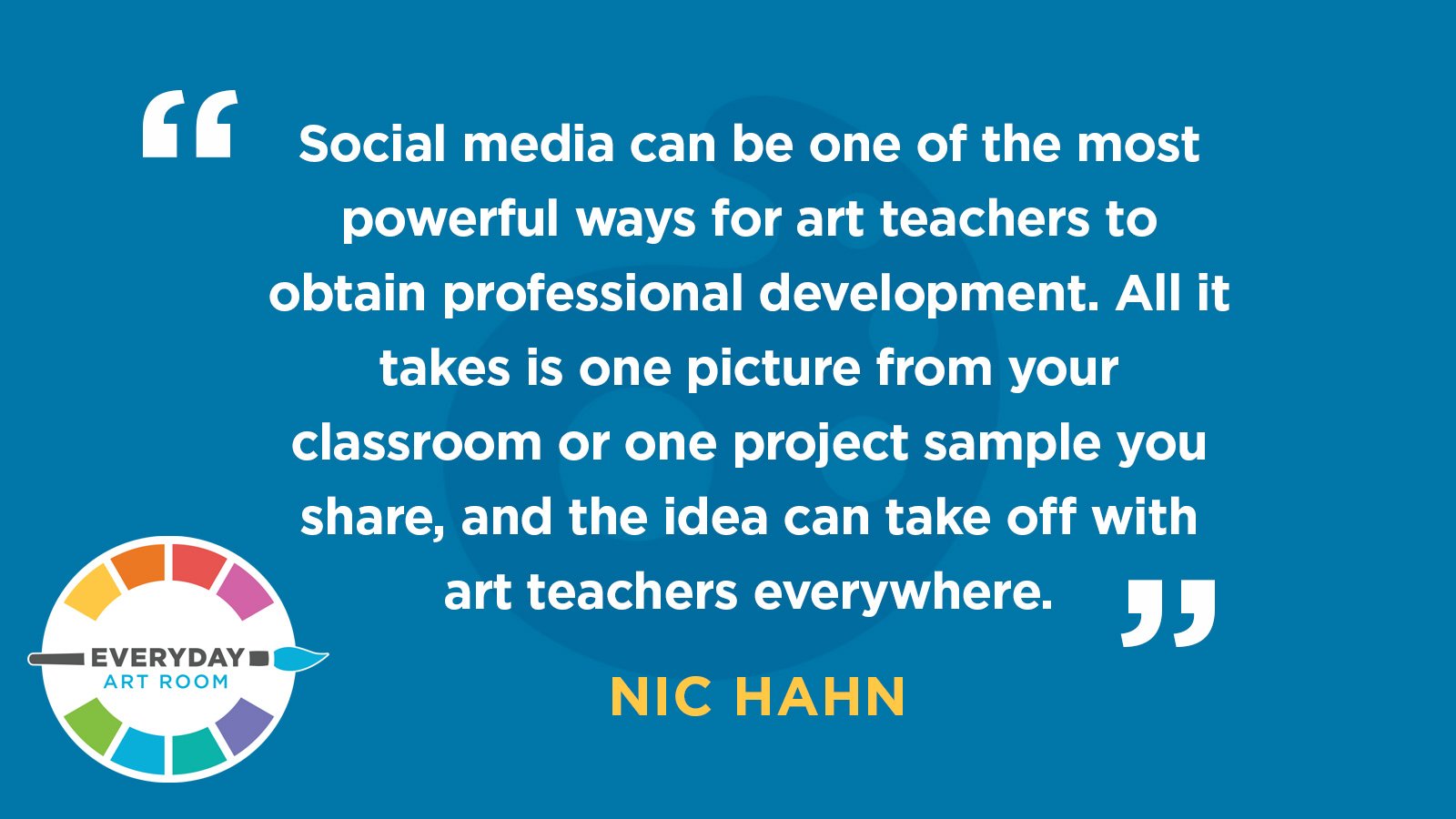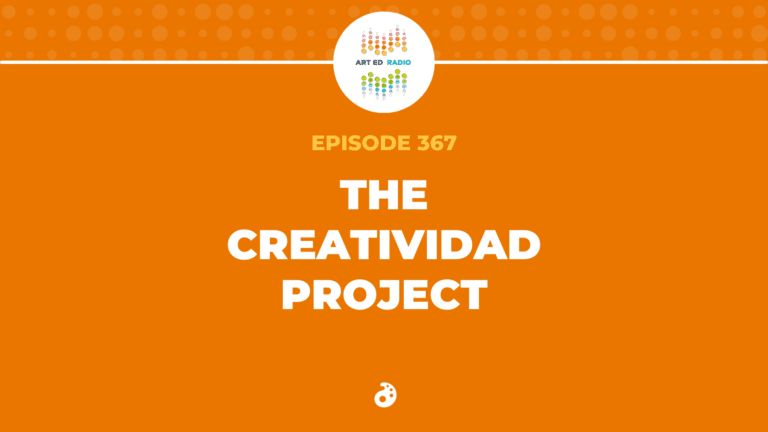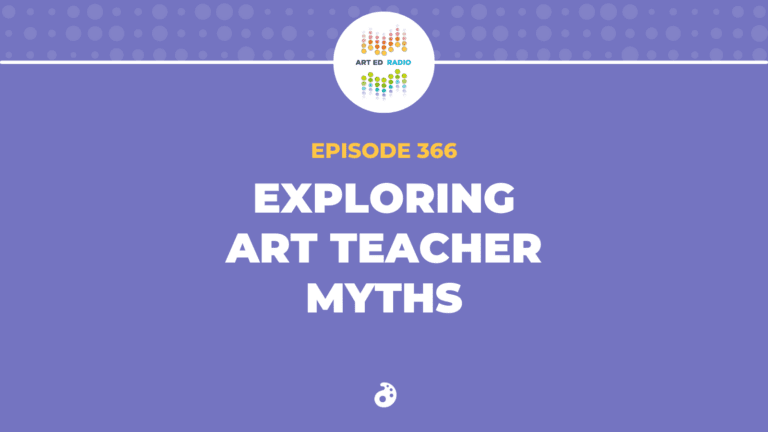Social media can play a powerful role in the way we connect and collaborate as art teachers, allowing us to share ideas, build them out, and make them our own. In today’s episode, Nic discusses how ideas can develop, how we influence each other, and how we learn from what other teachers post. Listen as Nic tells the story of how a single lesson has spread, with the help of Poppy Phillips and Shana Gutterman. Full Episode Transcript Below.
Resources and Links
- Read Poppy’s Facebook post
- Follow Shana on Twitter and Instagram
- Check out the art of Charles McGee

Transcript
Nic: Social media can be one of the most powerful ways for art teachers to obtain professional development. All it takes is one picture of something happening in your classroom or a project sample that you’re working on that can spark a whole different beast in someone else’s brain. What we do when we share information is we are planting seeds for more people to grow ideas and inspiration off from what you are posting. Today, we’re going to talk about that whole idea of planting a seed and watching the ripple effect of the plants that grow from your tiny little seed. This is Everyday Art Room, and I’m your host, Nic Hahn.
Today, I’m going to talk about social media as a garden. So stick with me here for a moment. There is a beautiful garden up north, it’s in St. Cloud, Minnesota. It’s called Munsinger’s Garden. It’s not huge by any means, but it really is a treasured place for myself and for my family to visit. It’s separated into some different garden sections. There’s a rose garden. There’s a spring garden. There are shaded-type flowers and greenery. It’s really well done, well put together. Even though when you go there, you’re spending time in nature of all sorts, flowers and greenery and shrubbery, you know that you’re walking into this area where you’re going to receive nature.
This is a little bit like social media to me, especially when we are talking about Facebook. When you become a Facebook member of different groups, you’re going to find similar flowers. So there is one Facebook group that we’re going to speak about today and it is called the Elementary Art Teachers Facebook Group. It’s absolutely huge. There are members from all over the world and these art teachers post questions, post comments, post lesson plan ideas, post resources, or … Man, and you name it, this is being posted. What makes it all part of the same section of the garden is that most of these people belong or spend most of their time in the elementary setting. There are other parts of the garden such as the Middle School Facebook Group. There is a TAB or choice-based Facebook group. There’s an Online Art Teacher Facebook Group. There are all sorts of Facebook groups that you can join in, in this garden of social media, and no matter where you walk into, you’re going to find little seeds that can go into your brain and develop into something different for your classroom, for your students.
There is a lesson plan or project sample that I’ve been seeing quite a bit on Instagram and on Facebook. I’m going to try to describe it the best that I can. It is bold solid lines with design within it, kind of Zentangle-looking. The bold lines are then cut out to create these irregular strips of paper. The irregular strips of paper are glued down in a sculptural way to allow them to fold on top of each other and weave and bend around one another to create a miniature paper sculpture. These are so cool, just stunning-looking project samples. I think people have started to grab a hold of it and give it a try in their classroom as well by just looking at the posts on Instagram and Facebook.
One of the places that I saw this lesson and the process and the stunning result is from Shana Gutterman’s Instagram account. We will, of course, have it in our podcast notes. She posted this amazing sculpture that her students did. So I wrote her and said, “Hey, can you tell me more about this artwork? Is this an original idea to you, to your classroom, or were you inspired by someone else?” She wrote back very quickly and said, “Actually, I saw posts similar to this from a woman named Poppy on Facebook, in a Facebook group.” I reached out to Poppy who was also willing to join us today. She’s going to start this conversation out to just introduce herself and then also explain her project and how it began in her world.
Poppy: Hi, there. My name is Poppy Phillips. I’m an art educator based in the UK. I’ve taught art and design for nearly 30 years initially in the primary phase, but for the last 20 years as a high school teacher. More recently, I’ve been working as an art and maths teacher in the Middle East. I’m passionate about all things art, all things education, and I thoroughly enjoyed looking at the links between the two different subjects I’ve been teaching. I’ve just been appointed head of art at an independent prep school here in the UK and I’m excited at the opportunity to be working with elementary and middle schoolers once again. My new appointment will see me working with younger children, something I haven’t done for several years, and I’ve been researching and resurrecting a number of old ideas in preparation for this role.
All of my initial planning focuses on the development of official vocabulary for learners, so the starting point when beginning new work is how the formal elements will be embedded within a lesson or unit. In this lesson, I wanted students to develop a comprehensive understanding of line and the vocabulary relating to it. I’ve often had students record line in their sketchbooks, looking at variations in length, width, and direction, but I wanted to develop this so that there was a purposeful outcome to the exploratory task.
Many years ago, I used to implement a small sculpture project based on the work of Alexander Calder, which explored complimentary color. I felt that a similar paper sculpture would be the perfect outcome to compliment the line activity. For this lesson, I simply ensured one side of A4 paper was fully covered. Working on a portrait format, the page was separated into about 10 sections using wavy lines. Even at this early stage, we are choosing language to support the understanding of the formal element. Following a class discussion, each section is then filled with a different type of line. Learners are encouraged to think about how lines flow, how the weight, direction, and length can impact on their design. Having drawn different types of line, learners cut the page across the initial wavy lines to create 10 separate samples. It’s always great to have additional cutting practice for small hands.
Students are then taught to bend, fold, weave, and manipulate paper to create an interesting sculpture, and we even throw in a little language teaching. Teaching them to count to 10 in a foreign language whilst holding down each strip of paper and waiting for the glue to dry. For me, this project is very much about accessing a visual vocabulary so it’s important that it takes place at the beginning of the school year. Line is inherent in so much of what we undertake in art and design and I want my students to have a clear understanding of this from the offset. It’s a great starter to set routines with learners, creative but controlled, limited materials but with an outcome that packs a visual punch. The goal is to enable learners in year three to demonstrate a knowledge of line and how they can use it.
The initial share was undoubtedly down to the sheer excitement of securing a new job. Specialist art roles in middle schools are not common here in the UK. I came home from interview and immediately started planning and creating examples, as for the first time in a long time, I will have full autonomy over what I can teach. This was the first refined outcome I completed and I was keen to share what I believed was a successful little project.
I have been a member of several groups on social media for a short time now. Teaching overseas can be a little challenging in terms of CPD opportunities. Obviously, there is online training, but the opportunity to reach out and meet similarly minded educators is becoming increasingly challenging. I have found the elementary art teachers group both inspiring and supportive. Being part of an online community of art teachers is vastly rewarding. It sparks ideas and helps develop classroom practice. I wanted to give something back, so in sharing this activity, I was delighted when I saw the work Shana had produced.
Nic: Poppy’s explanation of why she posted is something that made me very excited. Do you remember that feeling? That feeling of a new job, new autonomy, new exciting things to come? Even just listening to her explain that gets me just like butterflies in my stomach. That’s the way every new school year is for me. But to come back into the classroom in a position that’s going to make you so happy and have that flood of creativity just happen in your head, I can see why she wanted to shout it out through the rooftops. That’s where Shana comes in. Let’s have her introduce herself.
Shana: Hi, I’m Shana. I teach art all the way from kindergarten through eighth grade in Florida. Before I became an art teacher, I worked in the toy industry as a package designer and a product manager. I’ve created and designed educational toys. This past job experience has greatly influenced how I approach teaching art to my students. It is so important to be a connected educator. The pandemic has made it even more important to be part of a community of sharing with teachers. Many art education groups from during this time and teachers shared not only their lessons, but their processes and presentations. Social media also gave educators a way to ask questions and collaborate with each other.
One of the many groups that I’m part of is the Facebook group called Elementary Art Teachers K Through Five. This is where I found the sculpture lesson by Poppy Phillips. It was so visually stunning and it seemed like something that would also be manageable while teaching from a cart this year. In the Facebook thread, another art teacher, Corey Lee, mentioned artist, Charles McGee, could be an inspirational artist associated with this lesson. I spent the next few days researching contemporary artist, Charles McGee, and was amazed not only with his art, but also his life story.
I have many favorite parts of my job, learning and researching artists is definitely one of them. Charles McGee was from Detroit and he actually just recently passed away at age 96. Charles McGee’s life is incredible and inspiring, and there’s so much more to him than I have time to mention. He created murals around Detroit in addition to large sculptures. United We Stand is a sculpture that’s about 25 feet tall and it’s in front of the Wright Museum of African-American History. Unity is a mural, which is over 100 feet tall on the side of a building. McGee served in the Marine Corps in World War II, and he used the GI Bill to take some art classes. I found this really interesting because I just finished reading Ninth Street Women. The book takes place the same time period that McGee was an active artist and it also talks about how the GI Bill helped so many Army veterans attend art school after World War II. In 1969, McGee organized an exhibit called Seven Black Artists. He also established Gallery Seven. He was the founder of the Contemporary Art Institute of Detroit. He was a mentor for many artists. He also taught at the University of Michigan.
The more I learned about Charles McGee, the more the lesson evolved and still evolves. There are so many parts to this lesson. The students learned about Charles McGee, his journey, and how he gave back to his community, and then they studied his sculpture United We Stand that is displayed in front of the Wright Museum of African-American History. After that, they played a game of I Spy using the elements of art with the United We Stand. So they can say, “I spy texture,” “I spy color,” and then go into detail depending on what grade was doing the project. Students analyze United We Stand and its meaning. Even though there are so many individual components to the sculpture, they all come together to form unity. This leads us to our next discussion.
Charles McGee said that the world is my canvas. In our school, we practice the Hebrew phrase tikkun olam, which means repairing the world. Tikkun olam is a concept in Judaism that means social action. Students discuss both sayings and how they can make the world a better place to live in.
Nic: Both Shana and Poppy’s cite a comment from Corey Lee as one of the more pivotal points to the development of this lesson.
Poppy: What has been particularly special for me in this whole process is the comments that were made by Corey Lee. I met Corey just by chance several months ago, whilst working in Muscat and found her most inspiring. Her enthusiasm for art teaching was fantastic and I’m grateful that she introduced me to the work of Charles McGee on my initial post. Whilst I’ve not come across his work before, there are obvious links to this project and I will most certainly use his work. I now intend to use McGee’s work as a starting point when delivering this in the future. Like Shana, I was inspired by the phrase, “The world is my canvas,” and intend to make this the motto in my new classroom this coming September.
Nic: Do you see how this one single seed, this one share of an idea on Instagram or on Facebook went back and forth and back and forth, not only developed the idea in someone else’s brain, but when that plant grew and was shared back, it developed more ideas in Poppy’s lesson or gave her more resources because of the conversation that took place with one single post. This gets me so excited. This makes me so happy because this is what art education is all about. Sharing our ideas, building off from one another, collaborating as much as possible even across the world. How exciting to be a part of that. How exciting to share and acknowledge one another. I know that not only do the art teachers in this conversation benefit, but thousands and thousands and thousands of students do as well.
I often find inspiration on social media. When I use the inspiration, I try to reach out to that individual and ask, “Hey, is it all right if I quote you or repost your work? Is it okay if I use your idea to build off from?” Almost always, I get a big old, “You bet, go ahead. This is great.” I even find that we build off from each other most often. So their idea I might develop a video for, and then they can use it in their classroom or others can. Sometimes I develop a sheet, like a resource sheet of some sort. That’s a gift that I’m trying to give back to that art teacher saying, “Thank you. I love what your brain, your idea made my brain come up with. Let me thank you by giving you a resource back.” We may not have a group within our building that truly gets us or understands us. Many of us are singular in our school setting, we are the only art teacher. But when we go beyond ourselves onto social media, we often find each other and are inspired by each other. Let’s continue to collaborate and share.
I truly enjoyed hearing the conversation between Poppy and Shana as they explained the growth and development of the lesson that they now share. If you are looking for the visual aspect of these projects, make sure that you visit the podcast notes. Check out where Shana and Poppy’s links go so that you can follow them and connect with them separately. They both have some amazing work and amazing inspiration to share with you.
Speaking of finding inspiration online, let me invite you to The Art of Education University’s Art Ed NOW Conference. It’s a biannual conference designed just for our teachers. The next one that we will be participating in is July 29, 2021. That’s coming up right around the corner. It’s not too late or too early to sign up. In fact, if you do it soon, you have an opportunity to get a swag box and, believe me, you’re going to want this swag box. Be sure to check it out on The Art of Education University’s home page. You can look up at the top where it says NOW Conference. We will be releasing our speakers and presentations coming up here in the next couple of weeks. It’s always really exciting for me. I love this conference. I hope to see you there.
Magazine articles and podcasts are opinions of professional education contributors and do not necessarily represent the position of the Art of Education University (AOEU) or its academic offerings. Contributors use terms in the way they are most often talked about in the scope of their educational experiences.



